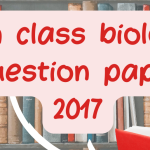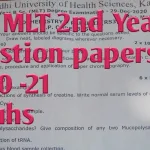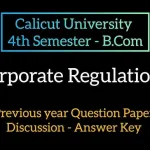Punjab University question papers for MSC-Botany, MSC-Zoology, MA-Economics, and MA-Hindi. These papers are valuable study materials to help you prepare for exams.
Topics covered in following pu old papers include plant and animal sciences, economics, and Hindi language and literature.
MSC-Botany PU Old Papers
Question: Explain the structure and function of chloroplasts in plant cells.
Answer: Chloroplasts are organelles that conduct photosynthesis. They have an outer membrane, an inner membrane, and a thylakoid membrane system. Chlorophyll within the thylakoids captures light energy, converting it into chemical energy stored in ATP and NADPH.
Question: Describe the process of nitrogen fixation in plants.
Answer: Nitrogen fixation is the conversion of atmospheric nitrogen (N2) to ammonia (NH3) by certain bacteria and cyanobacteria. In plants, this usually occurs in root nodules, with bacteria like Rhizobium facilitating the process.
Question: What are the differences between C3 and C4 plants?
Answer: C3 plants fix CO2 directly via the Calvin cycle, while C4 plants initially fix CO2 into a four-carbon compound. C4 photosynthesis is more efficient under high light intensity and temperatures.
Question: Discuss the role of gibberellins in plant growth.
Answer: Gibberellins are plant hormones that promote stem elongation, seed germination, and flowering. They break dormancy in seeds and stimulate enzyme production in germinating seeds.
Question: Explain the significance of secondary metabolites in plants.
Answer: Secondary metabolites, such as alkaloids, terpenoids, and phenolics, are not directly involved in growth but play roles in defense against herbivores, pathogens, and in attracting pollinators.
Question: How do plants respond to light and gravity?
Answer: Plants respond to light through phototropism, where they grow towards the light source. They respond to gravity through gravitropism, where roots grow downward (positive gravitropism) and shoots grow upward (negative gravitropism).
Question: What is the importance of mycorrhizae in plant nutrition?
Answer: Mycorrhizae are symbiotic associations between fungi and plant roots that enhance nutrient uptake, particularly phosphorus, and improve plant resistance to diseases.
Question: Describe the process of transpiration in plants.
Answer: Transpiration is the loss of water vapor from plant aerial parts, mainly through stomata. It helps in nutrient transport, cooling the plant, and maintaining water uptake from roots.
Question: What are the different types of plant tissues and their functions?
Answer: Plant tissues include meristematic (growth), epidermal (protection), ground (storage, support, photosynthesis), and vascular tissues (transport of water, nutrients, and food).
Question: Explain the concept of photoperiodism in plants.
Answer: Photoperiodism is the physiological reaction of organisms to the length of day or night. In plants, it influences flowering and other developmental processes, with some plants requiring specific day lengths to flower.
[save_as_pdf_pdfcrowd]
MSC-Zoology PU Old Papers
Question: Describe the structure and function of the mammalian heart.
Answer: The mammalian heart has four chambers: two atria and two ventricles. It pumps oxygenated blood to the body and deoxygenated blood to the lungs through systemic and pulmonary circuits, respectively.
Question: What is the role of the nephron in kidney function?
Answer: The nephron is the functional unit of the kidney, responsible for filtering blood, reabsorbing essential nutrients, and excreting waste products as urine.
Question: Explain the process of synaptic transmission in neurons.
Answer: Synaptic transmission involves the release of neurotransmitters from the presynaptic neuron into the synaptic cleft, which then bind to receptors on the postsynaptic neuron, generating an electrical signal.
Question: What are the main stages of insect metamorphosis?
Answer: Insect metamorphosis includes egg, larva, pupa, and adult stages. Holometabolous insects undergo complete metamorphosis, while hemimetabolous insects undergo incomplete metamorphosis.
Question: Discuss the evolutionary significance of the amniotic egg.
Answer: The amniotic egg allowed vertebrates to reproduce on land without the need for water, providing a protective environment for the developing embryo with membranes for gas exchange, waste removal, and nutrient transfer.
Question: How does the structure of bird feathers contribute to flight?
Answer: Bird feathers have a central shaft and barbs that interlock to form a light and strong surface, providing lift and enabling maneuverability during flight.
Question: What are the different types of animal tissues and their functions?
Answer: Animal tissues include epithelial (covering and protection), connective (support and structure), muscle (movement), and nervous tissues (control and communication).
Question: Describe the role of the lymphatic system in the immune response.
Answer: The lymphatic system transports lymph, a fluid containing immune cells, throughout the body. It helps in the detection and removal of pathogens, and lymph nodes act as sites for immune cell activation.
Question: What are the differences between prokaryotic and eukaryotic cells?
Answer: Prokaryotic cells lack a nucleus and membrane-bound organelles, while eukaryotic cells have a defined nucleus and organelles. Prokaryotes include bacteria and archaea; eukaryotes include plants, animals, fungi, and protists.
Question: Explain the concept of natural selection and its role in evolution.
Answer: Natural selection is the process by which organisms better adapted to their environment tend to survive and reproduce, passing on advantageous traits to offspring. It drives the evolution of species.
[save_as_pdf_pdfcrowd]
MA-Economics PU Old Papers
Question: Define and explain the concept of price elasticity of demand.
Answer: Price elasticity of demand measures the responsiveness of quantity demanded to a change in price. It is calculated as the percentage change in quantity demanded divided by the percentage change in price.
Question: Discuss the Keynesian theory of aggregate demand.
Answer: The Keynesian theory posits that aggregate demand is the total demand for goods and services in an economy at a given price level and is influenced by consumption, investment, government spending, and net exports.
Question: What are the main features of a perfectly competitive market?
Answer: A perfectly competitive market has many buyers and sellers, homogeneous products, free entry and exit, perfect information, and no single participant can influence the market price.
Question: Explain the difference between nominal and real GDP.
Answer: Nominal GDP is the total value of goods and services produced in an economy at current prices, while real GDP is adjusted for inflation, reflecting the true value of goods and services in constant prices.
Question: What is the role of central banks in managing inflation?
Answer: Central banks manage inflation through monetary policy tools such as interest rates, open market operations, and reserve requirements to control money supply and influence economic activity.
Question: Describe the concept of comparative advantage in international trade.
Answer: Comparative advantage refers to the ability of a country to produce a good or service at a lower opportunity cost than others, leading to more efficient trade and specialization.
Question: Discuss the effects of fiscal policy on economic growth.
Answer: Fiscal policy, through government spending and taxation, can stimulate or slow down economic growth by influencing aggregate demand, investment, and consumption.
Question: What are the causes and consequences of unemployment?
Answer: Causes of unemployment include cyclical downturns, structural changes, and frictional factors. Consequences include loss of income, decreased economic output, and social costs like increased poverty and crime.
Question: Explain the concept of the Lorenz curve and Gini coefficient.
Answer: The Lorenz curve represents income distribution within an economy, and the Gini coefficient quantifies income inequality, ranging from 0 (perfect equality) to 1 (perfect inequality).
Question: What is the significance of human capital in economic development?
Answer: Human capital, the skills, knowledge, and experience possessed by individuals, is crucial for economic development as it enhances productivity, innovation, and economic growth.
[save_as_pdf_pdfcrowd]
MA-Hindi PU Old Papers
Question: तुलसीदास के काव्य में भक्ति भावना का वर्णन कीजिए।
Answer: तुलसीदास के काव्य में भक्ति भावना मुख्यतः राम के प्रति है। वे भगवान राम को एक आदर्श व्यक्ति और मर्यादा पुरुषोत्तम मानते हैं और उनके काव्य में राम की भक्ति, सेवा और नामस्मरण का महत्व बताया गया है।
Question: आधुनिक हिंदी साहित्य में प्रेमचंद का योगदान क्या है?
Answer: प्रेमचंद ने हिंदी साहित्य में यथार्थवाद को स्थापित किया। उनके उपन्यास और कहानियाँ ग्रामीण जीवन, सामाजिक समस्याओं और मानवीय भावनाओं का सजीव चित्रण करते हैं।
Question: सूरदास के काव्य में कृष्ण की बाल लीला का महत्व बताइए।
Answer: सूरदास के काव्य में कृष्ण की बाल लीलाओं का विशेष महत्व है। उन्होंने कृष्ण के बाल्यकाल के चमत्कारिक और मनमोहक घटनाओं का वर्णन किया है, जो भक्ति रस से ओतप्रोत हैं।
Question: हिंदी साहित्य में छायावाद के प्रमुख कवियों के नाम बताइए।
Answer: छायावाद के प्रमुख कवि जयशंकर प्रसाद, सुमित्रानंदन पंत, सूर्यकांत त्रिपाठी निराला, और महादेवी वर्मा हैं।
Question: कबीर के दोहों में समाज सुधार की भावना का वर्णन कीजिए।
Answer: कबीर के दोहे समाज सुधार की भावना से भरे हुए हैं। उन्होंने अंधविश्वास, आडंबर, जातिवाद और धार्मिक कट्टरता का विरोध किया और मानवता, प्रेम, और सत्य का प्रचार किया।
Question: हिंदी साहित्य के इतिहास में आदिकाल का महत्व क्या है?
Answer: आदिकाल हिंदी साहित्य का प्रारंभिक युग है, जिसमें वीरगाथा काव्य का विकास हुआ। इसमें धार्मिक, वीर रस, और लोकगाथाओं का महत्वपूर्ण स्थान है।
Question: ‘गोदान’ उपन्यास की संक्षिप्त समीक्षा कीजिए।
Answer: ‘गोदान’ प्रेमचंद का प्रसिद्ध उपन्यास है जो ग्रामीण भारत की सामाजिक और आर्थिक स्थितियों का यथार्थ चित्रण करता है। यह होरी और उसकी पत्नी धनिया की कहानी है, जो समाज की कठिनाइयों और संघर्षों का सामना करते हैं।
Question: ‘साकेत’ महाकाव्य में लक्ष्मण-उर्मिला के चरित्र चित्रण पर प्रकाश डालिए।
Answer: ‘साकेत’ महाकाव्य में लक्ष्मण और उर्मिला के चरित्र को उनके प्रेम, त्याग और कर्तव्यनिष्ठा के रूप में दर्शाया गया है। उर्मिला का त्याग और लक्ष्मण की भक्ति इस महाकाव्य की विशेषताएं हैं।
Question: हिंदी साहित्य में नई कविता आंदोलन के प्रमुख कवि कौन हैं?
Answer: नई कविता आंदोलन के प्रमुख कवि अज्ञेय, शमशेर बहादुर सिंह, केदारनाथ सिंह, और रघुवीर सहाय हैं।
Question: ‘राग दरबारी’ उपन्यास का मुख्य कथानक क्या है?
Answer: ‘राग दरबारी’ श्रीलाल शुक्ल का उपन्यास है जो ग्रामीण भारत की राजनीतिक और सामाजिक विडंबनाओं का चित्रण करता है। यह एक गांव शिवपालगंज की कहानी है जहां भ्रष्टाचार और अव्यवस्था का बोलबाला है।
[save_as_pdf_pdfcrowd]
Exam Pattern
MSC-Botany (Master of Science in Botany)
- Duration: 2 years (4 semesters)
- Type: Semester system
- Subjects: Plant Morphology, Taxonomy, Physiology, Ecology, Genetics, Biotechnology, etc.
- Question Types: Long answer, short answer, practicals, and theory-based questions
MSC-Zoology (Master of Science in Zoology)
- Duration: 2 years (4 semesters)
- Type: Semester system
- Subjects: Animal Diversity, Cell Biology, Genetics, Ecology, Physiology, Evolution, etc.
- Question Types: Long answer, short answer, practicals, and theory-based questions
MA-Economics (Master of Arts in Economics)
- Duration: 2 years (4 semesters)
- Type: Semester system
- Subjects: Microeconomics, Macroeconomics, Econometrics, Development Economics, etc.
- Question Types: Essay, short answer, problem-solving, and analytical questions
MA-Hindi (Master of Arts in Hindi)
- Duration: 2 years (4 semesters)
- Type: Semester system
- Subjects: Hindi Literature, Hindi Grammar, Hindi Poetry, Hindi Prose, History of Hindi Literature, etc.
- Question Types: Essay, short answer, literary analysis, and critical evaluation
Note:
- Each course may have specific variations in the exam pattern depending on the semester and subjects offered.
- Practical exams for MSC-Botany and MSC-Zoology may include lab work, experiments, and fieldwork in addition to theory exams.
Latest Posts
- Step-by-step guide to download and apply for jee mains admit card 202
- Comprehensive 2025 government holidays and recruitment details for job seekers
- JEE Mains Admit Card 2025: Your Step-by-Step Guide to Downloading the Hall Ticket
- Everything You Need to Know About 2025 Government Holidays Recruitment
- Comprehensive Guide to rrb d group recruitment 2025 – Eligibility, Vacancies, and Application
- Detailed guide to nps trust recruitment 2025 vacancies, eligibility and apply process
- Comprehensive guide to hpcl recruitment 2025 notification, vacancies, and application process
- ignou bed admission 2025 complete recruitment guide with eligibility and process
- Comprehensive Guide to Indian Army Agniveer Recruitment 2025 Notification and Jobs
- Everything You Must Know About CBSE Board Exams 2025 Changes & New Rules






